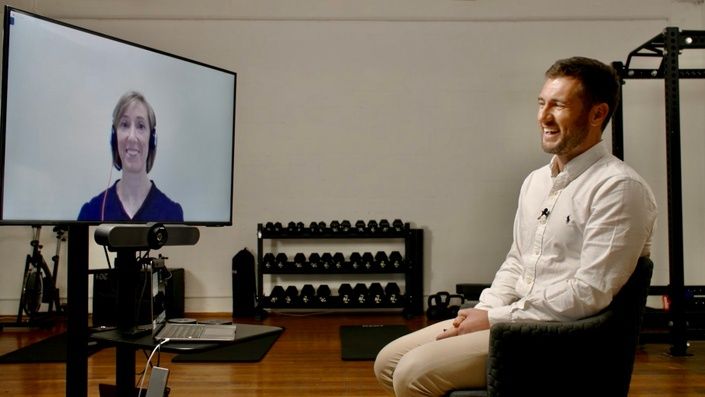Introduction
The Lumbar Spine Bone Stress Injury Masterclass, taught by Keren Faulkner and Dr Liam West, provides a comprehensive overview of the background, assessment, and management of lumbar spine bone stress injuries (BSI), exploring topics such as the role of imaging and preventative strategies. This position statement provides clinically relevant, actionable information that may be useful to health professionals.
Part 1: Background and Risk Factors
The mechanism for lumbar BSI is often repeated lumbar extension and rotation, such as in a fast bowler. However, axial load/compression is also important, such as when a gymnast lands from height. It is often our younger athletes who present with a lumbar BSI; when we see them, we should ask ourselves: Is this overload or under-recovery? Asking about changes in total training load or how many rest days they have can help to answer this.
- We must look beyond purely physical load as a risk factor for injury by also completing a thorough dietary screen, asking about quantity and quality of sleep, night pain, and screening for energy deficiency by checking for regular periods in females.
- Age is a significant risk factor for injury, particularly during growth spurts, as bone is immature and not prepared to take on high loads.
- The severity of injury is important, as a unilateral spondylosis is relatively stable and will cope well with load management, whilst a bilateral spondylosis is more unstable and has the risk of becoming a spondylolisthesis.
- The peak load, not so much total load, during an activity is most important when it comes to lumbar BSI as higher peak loads are more likely to lead to injury.
- We can help prevent lumbar BSI by a) addressing biomechanics with the help of the athlete’s coaches, b) addressing their loading, and c) screening for contributing factors which may predispose them to poor bone health such as low vitamin D or calcium, poor sleep, and de- loading the athlete during a growth spurt.
Part 2: Subjective and Objective Assessment
Given individuals with a lumbar BSI are often younger athletes, it is important to gain the trust of both the athlete and their parents early on to get a well-rounded understanding of the individual’s loading, growth, pubertal development and more. Further to this, physios need to have a good understanding of their athlete’s sport and biomechanics to understand where they need to derive movement from. For example, if a gymnast lacks hip extension during the splits, they will place more load through their lumbar spine.
- Our subjective assessment should screen for a history of lower back pain or bone stress injuries, as well as a thorough history of their load spanning back weeks before their pain started, including subtle changes such as their training surface or coach.
There is not a gold standard clinical test that can detect a lumbar BSI, however using the a) lumbar quadrant test and b) single leg lumbar extension tests are good pain provocation tests that can be used for reassessment. - Objective assessment should also look for a) the ability to dissociate between lumbar and hip flexion/ extension, b) lumbopelvic stability via an active straight leg raise, c) ruling out the SIJ, d) mobility of the thoracic spine especially into extension, e) hip mobility via a Thomas Test and f) gluteal and psoas strength.
- Imaging can be useful to detect the severity of injury, as a spondylosis vs a spondylolisthesis has implications for the stability and prognosis of the condition; a spondylolisthesis can be unstable and lead to long term consequences such as disc degeneration.
Masterclass Preview
Click on the play button to watch a FREE PREVIEW of the Lumbar Spine Objective Assessment that will be helpful in identifying those with a lumbar spine bone stress injury.
Part 3: Rehab and Return to Sport
Rehabilitation is not merely an opportunity to get the person back playing sport. Instead, it should be viewed as a chance to get on top of the issues that led to the problem in the first place, whether that be diet, loading or biomechanics. However, for the individual with multiple BSI or a really significant lumbar BSI, a conversation may need to be had around transitioning to another sport without the same demands on their spine.
- Progressions during lumbar BSI rehab must be pain free and criteria driven, not time driven. It is really important athletes are pain free at the time of returning to sport, afterwards and the next day; we should not normalise pain post sport.
- Our goals as clinicians during rehab should be to a) reduce load but find things they can do safely (bone heals well under appropriate load), such as cycling, rehab or water running, and b) set short term goals and timeframes to keep them engaged.
- Pay attention to morning stiffness and pain, as this will give insight to how they coped with the intervention from the day prior. Helpful ways to measure this are a) hopping and b) pain on lumbar extension first thing in the morning.
- Addressing thoracic and hip mobility and strengthening the multifidus muscle (as it helps with segmental motion of the lumbar spine) are good starting points for rehab.
- It may be worthwhile getting a repeat MRI to help confirm healing of the pars interarticularis and assist decision making regarding a return to sport.


